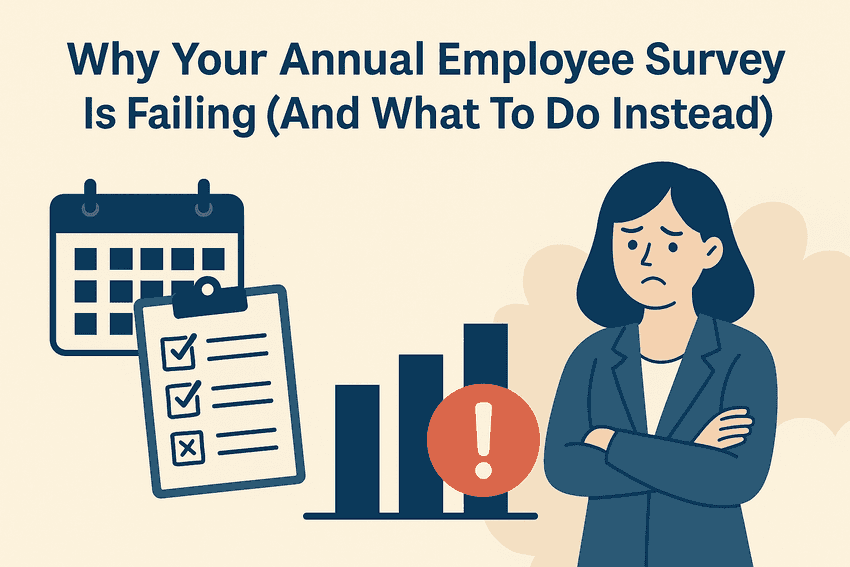HR’s Dirty Little Secret: Why Annual Surveys Fail & What to Do Instead
Table of Contents
- The Three Fatal Flaws
- The Pulse Check Alternative
- How One Company Fixed Meeting
- Your Four-Week Pulse Check
- Overcoming Common Objections
- The Results Speak for Themselves
- Getting Started Today
You pour months of effort into your annual employee engagement survey. The participation emails go out. The reminders follow. And when the results finally arrive months later, nothing meaningful changes.
This cycle isn't just frustrating, it's actively damaging your HR team's credibility. Employees increasingly see these surveys as corporate theater rather than tools for real improvement.
The problem isn't your intentions. It's your tools. Annual surveys are like getting a medical checkup once every five years and by the time you spot problems, they've already caused serious damage.

The Three Fatal Flaws of Annual Surveys
First, human memory simply doesn’t work the way annual surveys require. When you ask employees to rate their overall job satisfaction for an entire year, their brains can’t accurately reconstruct past emotions.
Neuroscience shows we anchor to recent events. A parking ticket on survey day or an argument with a coworker can skew responses by 20% or more. You’re not getting an accurate picture, you’re getting whatever emotion happened to be top of mind that day.
Second, the timeline guarantees irrelevance. By the time HR compiles results, analyzes trends, and develops action plans, the original concerns have often evolved or been replaced by new frustrations.
One manufacturing company discovered this the hard way. Their annual survey identified benefits confusion as a top concern in March. By the time they rolled out new educational materials in September, employees had moved on to complaining about meeting overload.
Third, and most damaging, is the trust erosion. When employees repeatedly share feedback but see no visible changes, they stop believing the process matters. Participation rates decline year after year, with your most disengaged employees—the ones whose feedback you need most—opting out entirely.
The Pulse Check Alternative
Forward-thinking HR teams are replacing annual surveys with pulse checks, which are short, frequent surveys that take less than 30 seconds to complete. These aren’t comprehensive diagnostics, but they provide something far more valuable: real-time insight into what employees are experiencing right now.
The mechanics are simple. Instead of one massive annual survey, you send one or two hyper-focused questions every week or two. Questions like How manageable is your workload this week? or Do you have the tools you need to do your best work?
Because these pulses are so brief, participation rates often exceed 80% - far higher than traditional surveys. More importantly, they allow you to spot and address problems while they’re still small and manageable.
How One Company Fixed Meeting Overload in 14 Days
Consider what happened at a mid-sized tech company when they implemented pulse checks. Their first question was simple: How many meetings today could have been an email?
Within three weeks, patterns emerged. The engineering team reported 72% of their meetings as unnecessary. Further pulses revealed these were mostly status updates that could be handled asynchronously.
HR worked with engineering leadership to implement No-Meeting Wednesdays and replace three weekly stand ups with Slack updates. The next pulse showed meeting satisfaction scores improving by 41%.
Critically, this entire cycle, from identifying the problem to implementing a solution to measuring improvement, took just 14 days. An annual survey would have missed the issue entirely until it was too late.

Your Four-Week Pulse Check Implementation Plan
Week one is for planning. Choose one pain point to focus on, preferably something managers already complain about. Workload, meeting effectiveness, and communication clarity are all strong starting points.
Design your first pulse question. Keep it brutally simple. If you’re measuring workload stress, try: How manageable is your workload this week? (1 = Drowning, 10 = Perfect). Avoid complex scales or ambiguous wording.
Week two is for launch. Send your first pulse to a pilot group, one department or a location. Use whatever tools you already have: email, Slack, Microsoft Forms, or free survey tools. The key is making participation effortless. There are, of course, much advanced tool for this but hey, we have to start somewhere.
Week three is for action. Identify the group with the lowest scores and have their manager ask one follow-up question: What’s one thing we could change this week to improve this? Then implement that change within seven days.
Week four is for scaling and communication. Share what you learned and how you responded with the entire team. Then expand your pulse program to additional departments or add a second question.
Overcoming Common Objections
Some leaders will argue pulse checks lack the rigor of annual surveys. When this happens, ask a simple question: “Would you rather have perfect data about last year’s problems or good-enough data to fix this week’s fires?”
Managers may worry about survey fatigue. In practice, the opposite occurs. Because employees see immediate action from pulse checks, participation often increases over time while annual survey participation declines.
The Results Speak for Themselves
Companies using pulse checks report dramatic improvements in both employee experience and HR’s strategic value. Participation rates typically run 2-3 times higher than annual surveys. Issues get identified and resolved 10 times faster.
Most importantly, employees start believing their feedback matters. One healthcare organization saw pulse participation grow from 68% to 93% over six months as word spread that HR was actually fixing problems.
HR teams using this approach consistently report stronger partnerships with operational leaders. When managers see concrete data about their team’s experience and simple ways to improve it, they become active allies in the employee engagement process.
Getting Started Today
The best part about pulse checks is how quickly you can begin. Unlike enterprise software rollouts or complex survey projects, you can launch your first pulse in under an hour.
Start small. Pick one question. Send it to one team. Then act on what you learn. The momentum will build naturally as employees and leaders see real problems getting real solutions.
Your annual survey was a postmortem. Pulse checks are preventative medicine. It’s time to stop autopsying last year’s cultural failures and start taking your organization’s vital signs in real time.
The question isn’t whether you can afford to try pulse checks. It’s whether you can afford not to.



